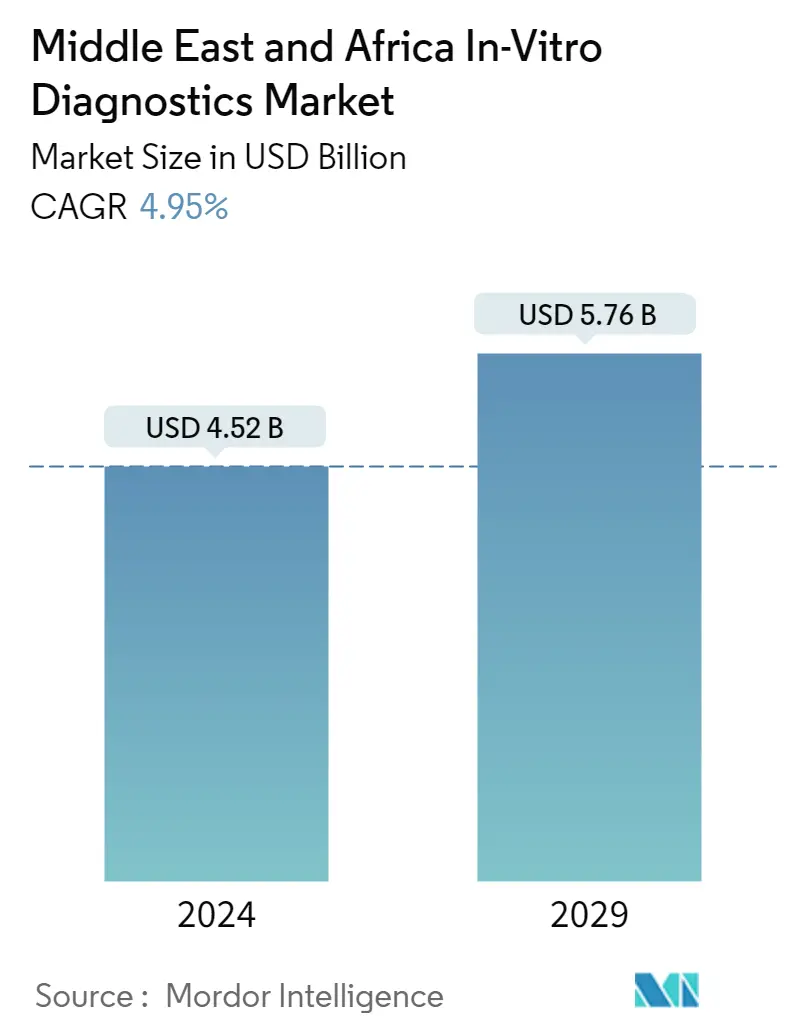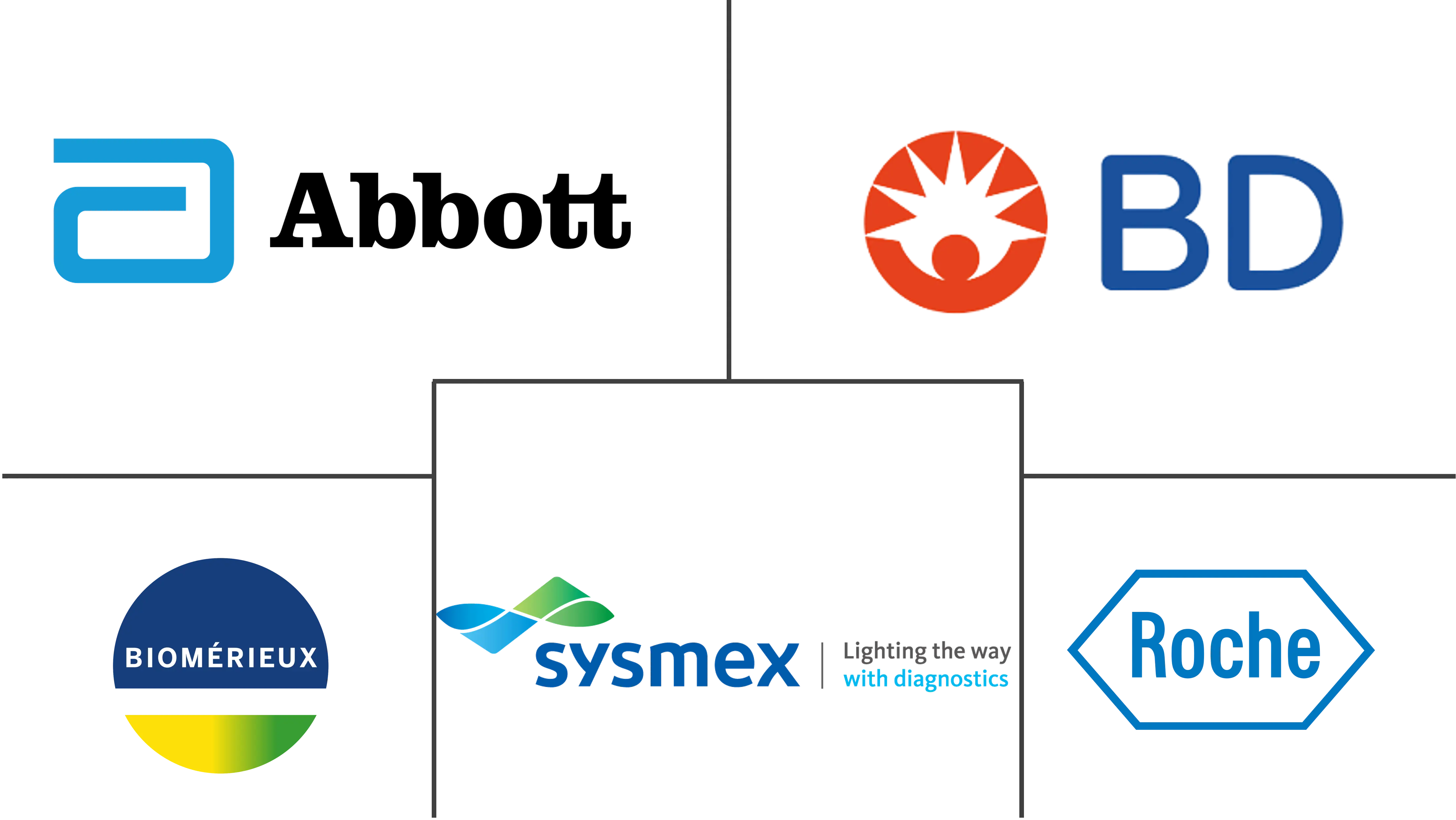Market Size of Middle East and Africa In-Vitro Diagnostics Industry

| Study Period | 2021 - 2029 |
| Base Year For Estimation | 2023 |
| Forecast Data Period | 2024 - 2029 |
| Market Size (2024) | USD 4.52 Billion |
| Market Size (2029) | USD 5.76 Billion |
| CAGR (2024 - 2029) | 4.95 % |
Major Players
*Disclaimer: Major Players sorted in no particular order |
Need a report that reflects how COVID-19 has impacted this market and its growth?
Middle East and Africa In-Vitro Diagnosis & Treatment Market Analysis
The Middle East and Africa In-Vitro Diagnostics Market size is estimated at USD 4.52 billion in 2024, and is expected to reach USD 5.76 billion by 2029, growing at a CAGR of 4.95% during the forecast period (2024-2029).
The COVID-19 pandemic had a significant impact on the in-vitro diagnostics market since there was an increasing demand for IVD kits and reagents for the rapid and accurate diagnosis of SARS-CoV-2 virus infection among the regional population. As per the 2022 report from the United Nations, with the help of several initiatives, including the establishment of the Regional Centre of Excellence for Genomic Surveillance and Bioinformatics in South Africa in collaboration with the SANBI at the University of Western Cape, the WHO increased the number of laboratories able to detect COVID-19 from two to more than 900. WHO also supported genetic sequencing efforts in Africa. In comparison to a year ago, these efforts resulted in more than 7,500 samples in the southern African region, and the amount of sequencing data on the continent increased by more than 54%. The efforts implemented by the government and related resources stimulated the market growth for in-vitro diagnostics in the studied region amid the pandemic. However, as per the analysis, the demand for IVD products may observe a slight decline post pandemic phase owing to a reduction in the number of infected patients and a surge in the vaccination rate across the region.
The major driving factor linked to the growth of the IVD industry in the region is the high burden of chronic diseases, especially infectious diseases, diabetes, and cancers. The Middle East and Africa region is majorly affected due to the burden of chronic diseases. As per the 2021 report from the International Diabetes Federation (IDF), 24 million adults (20-79) are living with diabetes in the IDF Africa Region. This number is estimated to increase to 33 million by 2030 and 55 million by 2045. As per the same source, 73 million adults (20-79) were living with diabetes in the IDF Middle East and North Africa region in 2021. This number is estimated to increase to 95 million by 2030 and 136 million by 2045. The prime factor responsible for this rising burden is the lack of a proper healthcare system across African countries and low awareness about novel disease diagnosis techniques. As per the 2022 review report from UNAIDS, law reform in Angola enabled the country to make use of funds from the Global Fund to combat AIDS, tuberculosis, and malaria to reach young members of critical populations by making it easier for more young people to obtain HIV testing services.
Thus, due to this rise in chronic diseases, the Middle East & Africa In-Vitro Diagnostics market is expected to witness growth over the analysis period. However, stringent regulations associated with the products may restrain the market's growth.
Middle East and Africa In-Vitro Diagnosis & Treatment Industry Segmentation
As per the scope of the report, in-vitro diagnostics is defined as a medical device used alone or in combination, intended by the manufacturer for the in vitro examination of specimens derived from the human body solely or principally to provide information for diagnostic, monitoring, or compatibility purposes. The Middle East & Africa In-Vitro Diagnostics Market is segmented by Technique (Histochemistry, Molecular Diagnostics, Hematology, Self-blood Glucose Testing, Immunochemistry, and Other Techniques), Product (Instrument, Reagent, and Other Products), Usability (Disposable IVD Device, Reusable IVD Device), Application (Infectious Disease, Diabetes, Cancer/Oncology, Cardiology, Autoimmune Disease, and Other Applications) End User (Diagnostic Laboratories, Hospitals and Clinics, and Other End Users) Diagnostic Approach (Point-of-Care Diagnostics and Centralized Laboratory-based Diagnostics) and Geography (GCC, South Africa, Rest of Middle East & Africa). The report offers the value (in USD million) for the above segments.
| By Technique | |
| Histochemistry | |
| Molecular Diagnostics | |
| Hematology | |
| Self-blood Glucose Testing | |
| Immunochemistry | |
| Other Techniques |
| By Product | |
| Instrument | |
| Reagent | |
| Other Products |
| By Usability | |
| Disposable IVD Device | |
| Reusable IVD Device |
| By Application | |
| Infectious Disease | |
| Diabetes | |
| Cancer/Oncology | |
| Cardiology | |
| Autoimmune Disease | |
| Other Applications |
| By End User | |
| Diagnostic Laboratories | |
| Hospitals and Clinics | |
| Other End Users (Academic and Medical School) |
| By Diagnostic Approach | |
| Point-of-Care Diagnostics | |
| Centralized Laboratory-based Diagnostics |
| Geography | |
| GCC | |
| South Africa | |
| Rest of Middle East & Africa |
Middle East and Africa In-Vitro Diagnostics Market Size Summary
The Middle East and Africa In-Vitro Diagnostics Market is projected to expand significantly in the coming years. This growth is driven by the high prevalence of chronic diseases such as infectious diseases, diabetes, and cancers in the region. The COVID-19 pandemic also significantly impacted the market, leading to an increased demand for IVD kits and reagents for the rapid and accurate diagnosis of the virus. However, the demand for IVD products may see a slight decline post-pandemic due to a reduction in the number of infected patients and an increase in the vaccination rate across the region. The market is competitive with several major players dominating the market in the GCC. These include Abbott Laboratories, BioMerieux SA, Sysmex Corporation, F. Hoffmann-La Roche AG, and Becton, Dickinson, and Company, among others. The diabetes segment, in particular, is expected to witness healthy growth due to the increasing burden of diabetes and the rising technological advancements in the field. The GCC in-vitro diagnostics market is also expected to grow due to the increasing healthcare expenditure and the growing burden of chronic diseases.
Explore MoreMiddle East and Africa In-Vitro Diagnostics Market Size - Table of Contents
-
1. MARKET DYNAMICS
-
1.1 Market Overview
-
1.2 Market Drivers
-
1.2.1 Growing Burden of Chronic Diseases
-
1.2.2 Increasing Use of Point-of-Care (PoC) Diagnostics
-
1.2.3 Increasing Use of Advanced Technologies
-
-
1.3 Market Restraints
-
1.3.1 Stringent Regulations
-
-
1.4 Porter's Five Force Analysis
-
1.4.1 Threat of New Entrants
-
1.4.2 Bargaining Power of Buyers/Consumers
-
1.4.3 Bargaining Power of Suppliers
-
1.4.4 Threat of Substitute Products
-
1.4.5 Intensity of Competitive Rivalry
-
-
-
2. MARKET SEGMENTATION (Market Size by Value - USD million)
-
2.1 By Technique
-
2.1.1 Histochemistry
-
2.1.2 Molecular Diagnostics
-
2.1.3 Hematology
-
2.1.4 Self-blood Glucose Testing
-
2.1.5 Immunochemistry
-
2.1.6 Other Techniques
-
-
2.2 By Product
-
2.2.1 Instrument
-
2.2.2 Reagent
-
2.2.3 Other Products
-
-
2.3 By Usability
-
2.3.1 Disposable IVD Device
-
2.3.2 Reusable IVD Device
-
-
2.4 By Application
-
2.4.1 Infectious Disease
-
2.4.2 Diabetes
-
2.4.3 Cancer/Oncology
-
2.4.4 Cardiology
-
2.4.5 Autoimmune Disease
-
2.4.6 Other Applications
-
-
2.5 By End User
-
2.5.1 Diagnostic Laboratories
-
2.5.2 Hospitals and Clinics
-
2.5.3 Other End Users (Academic and Medical School)
-
-
2.6 By Diagnostic Approach
-
2.6.1 Point-of-Care Diagnostics
-
2.6.2 Centralized Laboratory-based Diagnostics
-
-
2.7 Geography
-
2.7.1 GCC
-
2.7.2 South Africa
-
2.7.3 Rest of Middle East & Africa
-
-
Middle East and Africa In-Vitro Diagnostics Market Size FAQs
How big is the Middle East and Africa In-Vitro Diagnostics Market?
The Middle East and Africa In-Vitro Diagnostics Market size is expected to reach USD 4.52 billion in 2024 and grow at a CAGR of 4.95% to reach USD 5.76 billion by 2029.
What is the current Middle East and Africa In-Vitro Diagnostics Market size?
In 2024, the Middle East and Africa In-Vitro Diagnostics Market size is expected to reach USD 4.52 billion.
